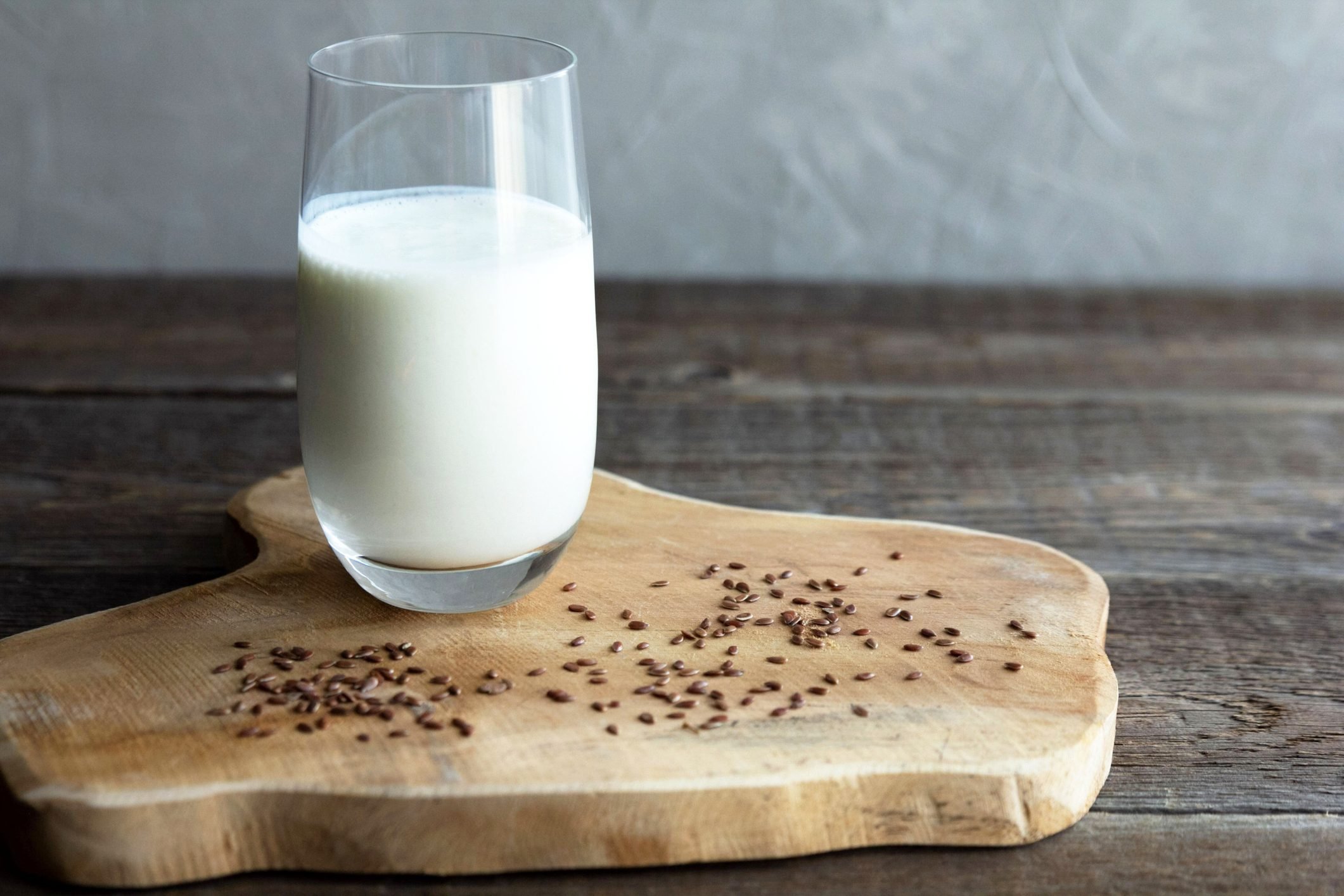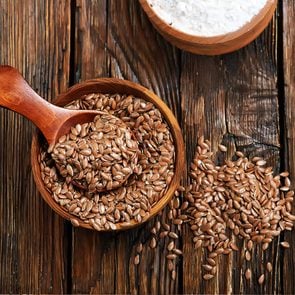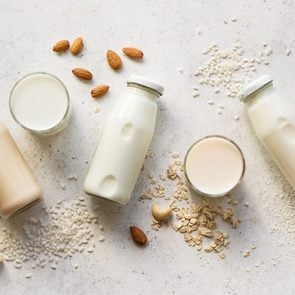What is Flax Milk? 10 Things Dietitians Want You to Know
Updated: Mar. 25, 2021
If you haven't tried flax milk yet, you should. Here's what to know about the nutrition, benefits, and varieties of this plant-based milk.
Our editors and experts handpick every product we feature. We may earn a commission from your purchases.
Why flax milk is a popular nondairy milk
As more and more plant-based milks make their way onto grocery store shelves, they’re becoming popular replacements for dairy milk. This is definitely the case for flax milk, made from—you guessed it—flaxseeds.
The milk, which has an earthy and nutty flavor, can be a terrific choice for folks following a vegan diet. It’s also fitting for people with allergies to nuts or dairy, as well as those who are lactose intolerant.
Not only does flax milk boast an ample amount of protein if it’s fortified, but it also contains other nutrients, thanks to its main ingredient: flaxseeds. When you drink flax milk, you get heart-healthy mono- and polyunsaturated fats, for example.
“Flax milk is a popular alternative for dairy milk because it’s just as high in calcium as dairy milk [if fortified], and it’s great to use in a variety of recipes,” says Elizabeth Gunner, a registered dietitian based in New York City.
Flax milk ingredients
Though all flax milk has flaxseeds, additional ingredients vary based on brand. Good Karma, for instance, sells milk that contains cold-pressed organic flax oil, pea protein, sea salt, and several vitamins. The pea protein in this milk amps up its protein content.
Another flax milk brand, Malibu Mylk, is made with organic flaxseeds, organic cinnamon powder, pink Himalayan salt, and a few other ingredients.
Varieties of flax milk
As with any type of milk—whether dairy or plant based—opting for unsweetened means you’re forgoing added sugars and added calories. If you prefer sweetened milk, check the nutrition label to see the added sugar content and where the added sugar comes from.
Take Good Karma flax milk. The company sells a lightly sweetened vanilla variety that contains 10 grams of added sugar per cup, its sweetness coming from cane sugar and vanilla extract. The brand’s chocolate flax milk is sweetened with cane sugar, vanilla extract, and natural cocoa—and has 10 grams of added sugar per cup. Good Karma’s unsweetened flax milk, on the other hand, contains no added sugar.
The original flavor Malibu Mylk, for comparison, has 5 grams of sugar from cane sugar. An unsweetened vanilla version has no added sugars and is flavored only with cinnamon and natural flavors.
Nutritional makeup of flax milk
The nutrients in flax milk differ by brand, so pay attention to a product’s nutrition label. Here are the nutritional benefits and daily value (DV) information for Malibu Mylk’s Unsweetened Flax.
One cup (8 ounces) contains:
Calories: 50
Fat: 3.5 g (5 percent of the daily recommended value, or DV)
Sodium: 85 mg (4 percent DV)
Carbohydrate: 4 g (1 percent DV)
Fiber: 3 g (12 percent DV)
Protein: 3 g (6 percent DV)
It contains a bit of calcium (4 percent DV) and iron (2 percent DV) and has no vitamin A or vitamin C. When flax milk is fortified with pea protein and vitamins, as are Good Karma’s milks, it can contain as much as 8 grams of protein per cup—as well as higher levels of other nutrients.
For example, it contains 2.3 micrograms (10 percent DV) of vitamin D, 320 milligrams of calcium (25 percent DV), 140 micrograms of vitamin A (15 percent DV), 1.4 micrograms of vitamin B12 (60 percent DV), and 240 micrograms of phosphorous (20 percent DV).

Flax milk may benefit heart health
Many plant-based foods boast heart-health benefits. Flaxseeds, which flax milk is made from, have a type of omega-3 fatty acid called alpha linoleic acid.
“In addition to being free of cholesterol and lactose, flax milk is rich in omega-3 fatty acids,” says Lisa R. Young, PhD, RDN, author of Finally Full, Finally Thin. “These have been shown to help reduce risk of cancer, heart disease, and strokes.”
The benefits may not stop there.
“A review study in Nutrients found that flaxseeds display powerfully protective effects in people with symptoms of cardiovascular disease,” says Kathleen Oswalt, a registered dietitian in Charleston, South Carolina.
“The most impressive result was the decrease in both systolic and diastolic blood pressure in people with peripheral arterial disease (PAD),” she says. “The individuals with PAD who ate about an ounce of milled flaxseed every day for six months showed significant decreases in both systolic and diastolic blood pressure.”
High blood pressure raises the risk for heart problems, so flaxseed’s blood pressure lowering effect may be one reason it’s linked to a lower risk of heart disease.
Flax milk may benefit weight loss
Flax milk has a protein content that’s higher than some plant-based milks, like almond milk. The protein level will be higher if the product is fortified with ingredients like pea protein, so check the nutrition label.
“The protein in flaxseed milk can help keep you full as well as help stabilize blood sugar levels,” says Young. “This is good for weight management and diabetes.”
Plus, there’s the fact that a cup of flax milk can have as few as 50 calories. Unfortunately, flax milk lacks the fiber that flax seeds contain.
Flaxseed may help blood sugar
In addition to keeping people satiated for longer, flax milk may help keep their blood sugar levels under control. That’s a benefit for people with type 2 diabetes.
“A study in Nutrition & Metabolism showed a significant reduction in fasting blood glucose levels,” says Oswalt. “In the study, participants with type 2 diabetes ate flaxseed baked into a cookie twice daily for three months. This amounted to just over two tablespoons of flaxseed daily.”
The study also showed a reduction in A1C levels, a two- to three-month measure of blood sugar levels. The A1C is used by doctors to determine how well managed a person’s blood sugar is, and lowering A1C levels is typically a goal for people who don’t have their blood sugar under control.
Keep in mind that flax milk’s potential to help manage blood sugar levels may be negated if you drink a variety with added sugar or that’s low in fiber. (Fiber often has a blood sugar-regulating effect, and the levels are naturally lower in flax milk than flaxseed.)
Pay attention to the nutrition label, opting for unsweetened flax milk with relatively high levels of calcium, which helps keep bones strong.
How to choose a flax milk
You have several options when choosing a flax milk. What you choose depends on whether you prefer a milk that has added protein (typically via pea protein) or is fortified with vitamins.
Additionally, you have a choice between sweetened and unsweetened varieties. Choose unsweetened to cut back on added sugar intake.
If you prefer a sweeter taste, you can always blend the milk with cinnamon, vanilla extract, or unsweetened cocoa powder.
How to make your own flax milk
If you’re feeling experimental in the kitchen, you can try your hand at blending up your own batch of flax milk.
Here’s how Gunner suggests making it: In a blender, combine 1/4 cup whole flaxseeds, 3 cups water, a little vanilla extract, and a pinch of salt.
Blend, pour the mixture into a container, and let it separate for about 10 minutes. Scoop out the flax matter on the top, and strain the rest of the milk with a nut bag.
The homemade milk will remain good for up to five days in the fridge.
Flax milk concerns
Drinking flax milk mostly has upsides. However, there are some people who may want to skip drinking the milk.
“Flaxseeds are rich in lignans, a type of phytoestrogen that is a plant nutrient similar to the hormone estrogen,” says Young. “While this is thought to help reduce the incidence of breast cancer, there still is a debate about the healthfulness of phytoestrogens for people at risk for estrogen receptor positive breast cancer.”
If you’re concerned, talk to your doctor before adding flax milk to your diet.
How to use flax milk
You can sub flax milk into almost any recipe that calls for dairy or plant-based milks. This includes smoothies and baked goods. And, of course, you can sip it straight or add it to a bowl of cereal.



